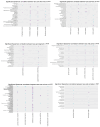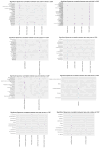Microbial Dynamics: Assessing Skincare Regimens' Impact on the Facial Skin Microbiome and Skin Health Parameters
- PMID: 39770857
- PMCID: PMC11728252
- DOI: 10.3390/microorganisms12122655
Microbial Dynamics: Assessing Skincare Regimens' Impact on the Facial Skin Microbiome and Skin Health Parameters
Abstract
The human skin microbiome, a complex ecosystem of microbes, plays a pivotal role in skin health. This study aimed to investigate the impact of two skincare regimens, with preservatives (CSPs) and preservative-free (PFPs), on the skin microbiome in correlation to skin quality. double-blind randomized cosmetic studywith a split-face design was conducted on 26 female participants. Microbial diversity and abundance were analyzed using 16S rRNA amplicon sequence data and skin quality utilizing the Antera 3D skin camera. We confirmed earlier studies on the identification of major skin microbial taxa at the genus level, including Cutibacterium acnes, Corynebacterium, and Neisseriaceae as a predominant part of the facial skin microbiome. Furthermore, microbiome profile-based subgrouping was employed, which revealed that the cluster, characterized by the Neisseriaceae family as its predominant organism, exhibited significant reduction in folds count, fine lines, and redness after application of PFP compared to CSP. A Spearman correlation analysis highlighted the correlation between changes in specific bacteria and skin quality parameters such as redness, pores, and texture in the context of comparing PFP and CSP. Overall, the PFP treatment demonstrated a greater number of significant correlations between bacterial changes and skin quality compared to the CSP treatment, suggesting a distinct impact of the preservative-free skincare regimen on the skin microbiome and skin quality. Our study provides insights into different microbiome-centered approaches to improve our understanding of the skin microbiome's interplay with skin quality but also highlights the need for larger, comprehensive research to further understand the microbiome's role in dermatology.
Keywords: 16S rRNA; dermatology; effects of skincare; microbiology; microbiome analysis; skin microbiome.
Conflict of interest statement
Johanna Maria Gillbro and Ulf Åkerström are employees of Skinome Research AB. The other authors have no conflicts of interest to disclose.
Figures












Similar articles
-
Randomized comparative double-blind study assessing the difference between topically applied microbiome supporting skincare versus conventional skincare on the facial microbiome in correlation to biophysical skin parameters.Int J Cosmet Sci. 2023 Feb;45(1):83-94. doi: 10.1111/ics.12826. Epub 2023 Jan 12. Int J Cosmet Sci. 2023. PMID: 36367009 Clinical Trial.
-
Longitudinal study of the interplay between the skin barrier and facial microbiome over 1 year.Front Microbiol. 2023 Nov 16;14:1298632. doi: 10.3389/fmicb.2023.1298632. eCollection 2023. Front Microbiol. 2023. PMID: 38033568 Free PMC article.
-
Impact of Leave-on Skin Care Products on the Preservation of Skin Microbiome: An Exploration of Ecobiological Approach.Clin Cosmet Investig Dermatol. 2023 Sep 29;16:2727-2735. doi: 10.2147/CCID.S409583. eCollection 2023. Clin Cosmet Investig Dermatol. 2023. PMID: 37794944 Free PMC article.
-
Dermatological Health in the Light of Skin Microbiome Evolution.J Cosmet Dermatol. 2024 Dec;23(12):3836-3846. doi: 10.1111/jocd.16557. Epub 2024 Sep 9. J Cosmet Dermatol. 2024. PMID: 39248208 Free PMC article. Review.
-
The skin barrier and microbiome in infantile atopic dermatitis development: can skincare prevent onset?Int Immunol. 2024 Oct 26;36(11):579-584. doi: 10.1093/intimm/dxae038. Int Immunol. 2024. PMID: 38887075 Review.
Cited by
-
SkinDuoTM as a Targeted Probiotic Therapy: Shifts in Skin Microbiota and Clinical Outcomes in Acne Patients.Int J Mol Sci. 2025 May 22;26(11):5000. doi: 10.3390/ijms26115000. Int J Mol Sci. 2025. PMID: 40507814 Free PMC article.
References
-
- Santamaria E., Akerstrom U., Berger-Picard N., Lataste S., Gillbro J.M. Randomized comparative double-blind study assessing the difference between topically applied microbiome supporting skincare versus conventional skincare on the facial microbiome in correlation to biophysical skin parameters. Int. J. Cosmet. Sci. 2023;45:83–94. doi: 10.1111/ics.12826. - DOI - PubMed
-
- Kong H.H., Oh J., Deming C., Conlan S., Grice E.A., Beatson M.A., Nomicos E., Polley E.C., Komarow H.D., Program N.C.S., et al. Temporal shifts in the skin microbiome associated with disease flares and treatment in children with atopic dermatitis. Genome Res. 2012;22:850–859. doi: 10.1101/gr.131029.111. - DOI - PMC - PubMed
LinkOut - more resources
Full Text Sources

